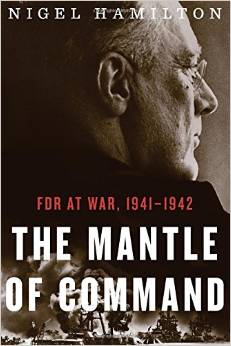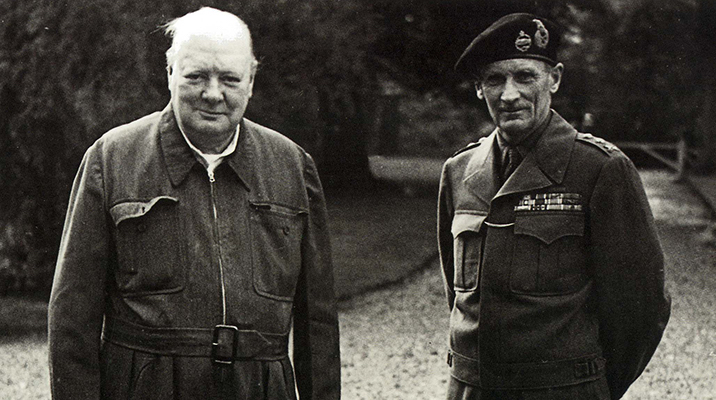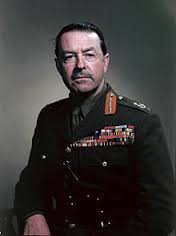
Finest Hour 173
Books, Arts, & Curiosities – The Forces of Justice

August 14, 2016
Finest Hour 173, Summer 2016
Page 46
Nial Barr, Eisenhower’s Armies: The American-British Alliance during World War II, Pegasus Books, 2015, 544 pages, $35. ISBN: 978–1605988160
Review by Nigel Hamilton
Nigel Hamilton is senior fellow in the John W. McCormack Graduate School of Policy and Global Studies. Dr. Hamilton is author of Monty, an award-winning three-volume biography of Field Marshal Bernard Montgomery. He is currently at work on a three-volume study of Franklin D. Roosevelt as US Commander in Chief during the Second World War. The second volume, Commander in Chief: FDR’s Battle with Churchill, 1943, was published in June 2016.
 Winston Churchill was born half-American— and ended his life as an honorary American. Educated as a soldier (at the Royal Military College, Sandhurst), moreover, he probably saw more combat in the field abroad than any US president or British prime minister. A military historian from his first books (The Story of the Malakand Field Force and The River War) to his near-last (The Second World War), he would have loved Niall Barr’s Eisenhower’s Armies: The American-British Alliance during World War II.
Winston Churchill was born half-American— and ended his life as an honorary American. Educated as a soldier (at the Royal Military College, Sandhurst), moreover, he probably saw more combat in the field abroad than any US president or British prime minister. A military historian from his first books (The Story of the Malakand Field Force and The River War) to his near-last (The Second World War), he would have loved Niall Barr’s Eisenhower’s Armies: The American-British Alliance during World War II.

2025 International Churchill Conference
Churchill—who had a wonderfully wry sense of humor—would also have been amused, I think, by the change of title as the book crossed the Atlantic—for it was originally published in Britain as “Yanks and Limeys.” (It bore, however, a less sensational subtitle, namely “Alliance Warfare in the Second World War.”)
Both titles are in reality misnomers, for whether it be Eisenhower’s Armies or Yanks and Limeys the 544-page book is far, far more than a study of US and British approaches to military alliance in the Second World War. A full third of the volume covers the period before the United States even entered the war, beginning in the year 1755 and carrying the reader up to Pearl Harbor.
This extended introduction to the subject could well have been published as a separate volume. As an examination of the difference between British and American professional military attitudes from colonial times to the Japanese sneak attack, then Hitler’s declaration of war on the United States four days later, this first section or history of British versus American ways of making war is in my opinion unsurpassed: intelligent, insightful and written in an uncommonly easy style. As Barr notes, “the idea of learning from one another or cooperation between the British and American armies” in the nineteenth century “was unthinkable,” thanks to the American Revolution and the War of 1812. The two nations’ armies—and approach to military education—thus proceeded on very different lines: the more so since the Civil War (“two armed mobs chasing each other around the countryside,” Barr quotes the widespread European view) was not considered to be relevant, nor its lessons worth using in training proud British army units. More effective colonial policing and the crushing of rebellion were, to the British, the great and abiding lessons they drew from America’s escape from the British Empire: an empire that had, after all, only grown larger since the split.

The First World War, however, finally brought the two nations’ militaries briefly back together. As Barr cautions, relatively few American commanders in the Second World War, at least in Europe, had in fact seen combat service in 1918—whereas there was scarcely a single British commander in the Second World War who had not experienced bitter fighting in the trenches of Flanders or elsewhere. This was to be a seminal, scarring difference: some twenty thousand British soldiers killed on the first day of the Battle of the Somme in 1916—and hundreds of thousands more in similarly futile battles.
Small wonder then, Barr makes clear, that British Second World War commanders like Montgomery were for the most part cautious and, in the American view, unadventurous or unimaginative.
For their part, innocence of such traumas would prove a blessing in many ways for senior American officers, however—the word “defeatism” never once being heard in American headquarters in the Second World War. By contrast— fueled by the disasters in Norway, Dunkirk, Greece, Crete and North Africa, as well as in Hong Kong, Singapore and Burma—the feeling that the Germans could not be beaten (at least, not without unacceptable casualties) would pervade most British and British imperial and Commonwealth formations until late 1942, when Montgomery restored morale and a belief in British victory.
The first part of Eisenhower’s Armies thus acts as a prelude to Anglo-American coalition warfare, once US forces landed in Algeria and Morocco in November 1942.
It is to Professor Barr’s great credit that he then proceeds to retell the well-known campaigns of the Second World War with a historian’s welcome objectivity, yet also an unfailingly human “take,” almost every page adding fresh detail or thoughtful interpretation.
I was first surprised that the author did not use some of the more recent works on the campaigns of the Second World War, such as Rick Atkinson’s “Liberation Trilogy.” It soon became clear, however, that he has beaten his own path in search of fresh commentary and insights, culled from diaries and unpublished documents still in American archives. His narrative thus remains fresh, original and constantly pleasing. Here is a historian mercifully without ax to grind in the Anglo-American strategic debates of the Second World War, only a fine teacher’s desire to lay out the challenges facing Anglo-American forces (war in the Pacific is not covered) in North Africa, the Mediterranean, and Europe—and how differently they were tackled by US and British commanders and troops, given their very different histories. And pay!
Most impressive, perhaps, among Barr’s qualities as a kind of retrospective observer of the war in the West, is his impartiality, mirroring that of General Eisenhower himself. Unlike so many British and American historians (Barr is British), he has proven himself capable of relentlessly honest critical assessment of Second World War strategy, operational planning, and field performance without national bias or prejudice—a remarkable achievement. In recounting Churchill’s intervention in Greece in the spring of 1941 and its sorry outcome, for example, Barr writes; “This catalogue of disasters gave the lie to any presumed British expertise in strategy”—something that would have dire implications “when the British continued to push for a Mediterranean strategy later in the war.” He quotes Major Bonner Feller’s reports from the faltering British campaign against Rommel in North Africa: “a devastating critique from the one American officer who had watched the British Army at close quarters.”
Equally, though, Barr is caustic about General Fredendall’s performance during the battle of Kasserine—describing the diary of the “somewhat humorless” British Signals general, Ronald Penney, who visited Fredendall’s US II Corps shortly before Rommel’s blitzkrieg attack. The Corps HQ was an astonishing sixty miles from the front, “literally dug into a hill” in fear of Luftwaffe attack, and “approached through a swamp,” Penney confided to his journal. Even Eisenhower, in Barr’s judgment, was remiss in not ordering Fredendall to pull his forward troops back to more defensible positions as Allied Commander in Chief, despite visiting him only hours before Rommel’s attack.
The battle proved a ghastly reverse, from top to bottom—i.e., from Allied Headquarters in Algiers down to the poor infantrymen in the Faid pass. But in terms of the Anglo-American learning curve it was a godsend. The German victory did nothing to avoid ultimate surrender by the Axis forces in North Africa, but did kick the Allies into more effective co-operation.
Penney had recorded that Fredendall was “full of ‘Jesus’—‘Son of a Bitch’—‘Goddammed’ etc. etc. but without the personality of Patton.” Patton was swiftly ordered to replace him—and the rest became history as US forces learned to fight and defeat their Wehrmacht opponents.
 For Eisenhower, however, this was just another addition to his woes, as he attempted to keep the Allies fighting the Germans, not each other. There were victories— but fiascos, too, such as Anzio, with considerable ill-feeling between commanders of national contingents. Barr, in my view, is far too kind concerning General Alexander, Eisenhower’s field deputy in the Mediterranean. Alexander was Churchill’s favorite general—because of his courage, imperturbability, and good looks. But Winston was not, for the most part, a good picker of men—and had Churchill had his way, and had he been permitted by the British Cabinet to appoint Alexander as Eisenhower’s land forces commander for the D-Day invasion, it is my humble opinion that D-Day would have failed—just as Anzio turned out to be a shambles.
For Eisenhower, however, this was just another addition to his woes, as he attempted to keep the Allies fighting the Germans, not each other. There were victories— but fiascos, too, such as Anzio, with considerable ill-feeling between commanders of national contingents. Barr, in my view, is far too kind concerning General Alexander, Eisenhower’s field deputy in the Mediterranean. Alexander was Churchill’s favorite general—because of his courage, imperturbability, and good looks. But Winston was not, for the most part, a good picker of men—and had Churchill had his way, and had he been permitted by the British Cabinet to appoint Alexander as Eisenhower’s land forces commander for the D-Day invasion, it is my humble opinion that D-Day would have failed—just as Anzio turned out to be a shambles.
Barr’s viewpoint, though, is that of alliance warfare—and from that perspective, as in the case of general Eisenhower, Alexander’s charm did ensure the two Allies kept facing the enemy, not each other. Which could not, sadly, be said of general Montgomery, who was appointed Allied Land Forces Commander under Eisenhower for the invasion.
To this day Bernard Montgomery’s name in America is close to mud, thanks not only to the prickly general’s boastfulness and press conferences during the Second World War, but his Memoirs, published in 1958, which trashed Eisenhower—who had since become a revered President of the United States!
Ironically, we thus have a strange situation where among serious American military historians Montgomery is rated, I have found, as by far and away the most professional Allied field commander of the Second World War—but cannot be canonized as such, owing to the abiding public disdain for him as a British pain in a proverbial part of the American psyche and anatomy!
It is to Barr’s further credit, then, that he has chronicled the story of US-British war-making from D-Day to Berlin with exemplary honesty, not pulling his punches, yet alive always to the difference between field combat and the highest, coalition aspects of command. Moreover he recognizes—as too many historians do not—that logistics determined, in the end, the progress or timetable of the war, even if they did not explain the battles.
“There is no question that by the end of October 1944,” Barr writes, “Eisenhower’s broad front strategy had run into the sand.” But with “units still training in the States, and others committed to the war in the Pacific, Eisenhower and his generals realized that the ‘90-division gamble,’” which was all the Pentagon could marshal, “left him with fewer than sixty divisions in Europe.” This was not enough to push his forces to the Rhine, indeed it was not enough “to provide a sufficient reserve,” as the Battle of the Bulge would soon demonstrate.
And so the war continued to its bitter end—moreover continued, as Barr writes, with no less fierceness after the last shots were fired, when the generals went into print.
“The Anglo-American alliance had always been more than the sum of its parts and far greater than the relations between a few men,” Barr wisely concludes. The Russians had refused to have anything to do with their coalition partners, on the battlefield, or above it, or at sea—Stalin paranoid that contact with an ally might expose the tyranny of his communist dream. But the United States did hunker down with its primary western ally, in the most extraordinary way, from LendLease to shared blood. And that Anglo-American story, in Barr’s telling, is at once noble and unforgettable, for all the tensions, rivalries, and disagreements between them. As such, Eisenhower’s Armies deserves to become a classic.
Subscribe
WANT MORE?
Get the Churchill Bulletin delivered to your inbox once a month.



